一个高中英语教学案例
教学叙事案例高中英语
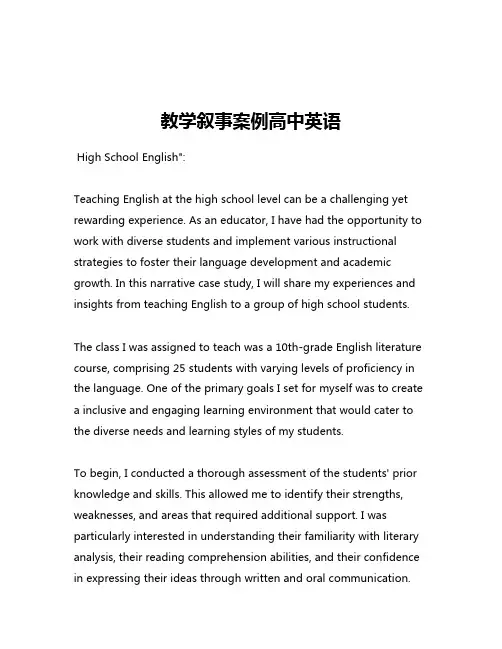
教学叙事案例高中英语High School English":Teaching English at the high school level can be a challenging yet rewarding experience. As an educator, I have had the opportunity to work with diverse students and implement various instructional strategies to foster their language development and academic growth. In this narrative case study, I will share my experiences and insights from teaching English to a group of high school students.The class I was assigned to teach was a 10th-grade English literature course, comprising 25 students with varying levels of proficiency in the language. One of the primary goals I set for myself was to create a inclusive and engaging learning environment that would cater to the diverse needs and learning styles of my students.To begin, I conducted a thorough assessment of the students' prior knowledge and skills. This allowed me to identify their strengths, weaknesses, and areas that required additional support. I was particularly interested in understanding their familiarity with literary analysis, their reading comprehension abilities, and their confidence in expressing their ideas through written and oral communication.Based on the assessment results, I designed a comprehensive curriculum that balanced the study of classic literary works with opportunities for students to develop their critical thinking, problem-solving, and communication skills. I carefully selected a range of texts, including novels, short stories, and poetry, that would not only expose the students to diverse literary genres but also challenge them to explore complex themes and universal human experiences.One of the key instructional strategies I employed was the use of interactive, student-centered activities. Instead of relying solely on lecture-based lessons, I incorporated group discussions, collaborative projects, and interactive presentations. This approach encouraged the students to actively engage with the material, share their perspectives, and learn from one another.For example, when we studied Harper Lee's "To Kill a Mockingbird," I divided the class into small groups and assigned each group a different theme or character to analyze. The students were tasked with conducting research, identifying relevant textual evidence, and preparing a presentation to share their findings with the class. This not only deepened their understanding of the novel but also developed their research, critical thinking, and public speaking skills.Furthermore, I placed a strong emphasis on the development ofwriting skills. Throughout the course, the students were required to complete various writing assignments, ranging from literary analyses to personal narratives. I provided detailed feedback on their work, focusing on aspects such as organization, coherence, and the use of evidence to support their arguments.One particularly memorable assignment was a creative writing exercise in which the students were asked to reimagine the ending of a classic short story. The students' imaginative and thought-provoking responses not only demonstrated their understanding of the original text but also showcased their ability to think critically and express their ideas in a compelling manner.In addition to the academic components of the course, I also recognized the importance of fostering a positive and supportive classroom environment. I made a conscious effort to get to know my students on an individual level, to understand their unique backgrounds, interests, and learning needs. This allowed me to tailor my instructional approach and provide personalized support when necessary.One student, in particular, stood out to me during this process. Emily was a quiet and reserved student who initially struggled with the demands of the course. However, through my one-on-one interactions with her, I discovered that she had a deep passion forpoetry and a keen eye for literary analysis. I encouraged her to share her insights during class discussions and to incorporate her love of poetry into her writing assignments.Over the course of the semester, I witnessed a remarkable transformation in Emily. She became more confident in her abilities, actively participated in class, and produced exceptional work that showcased her analytical and creative skills. This experience reinforced my belief in the power of personalized instruction and the importance of recognizing and nurturing each student's individual strengths and talents.Throughout the teaching experience, I also faced several challenges that required me to adapt and refine my instructional strategies. For instance, I encountered students with diverse learning styles, some of whom preferred visual aids, while others thrived in hands-on activities. I had to be flexible and incorporate a range of teaching methods to ensure that all students could access the content and engage with the material effectively.Additionally, I had to navigate the complexities of teaching sensitive topics, such as social injustice and cultural diversity, which were often present in the literary works we studied. I approached these discussions with empathy, sensitivity, and a commitment to fostering open and respectful dialogues among my students.Despite the challenges, the overall experience of teaching high school English was deeply rewarding. Witnessing the growth and development of my students, both academically and personally, was truly gratifying. I saw them evolve from passive recipients of information to active, critical thinkers who could articulate their ideas with confidence and clarity.In reflecting on this teaching narrative, I have gained valuable insights that will inform my future practice. I have learned the importance of adapting to the unique needs and learning styles of each student, the significance of creating a inclusive and supportive classroom environment, and the power of incorporating interactive and student-centered instructional strategies.As I continue on my journey as an educator, I am committed to building upon these experiences and constantly seeking ways to improve my teaching practice. By staying attuned to the ever-changing needs of my students and the evolving landscape of education, I hope to continue making a meaningful impact on the lives of the young people I have the privilege of teaching.。
信息技术融合创新应用成果——高中英语教学案例《乌鸦喝水》
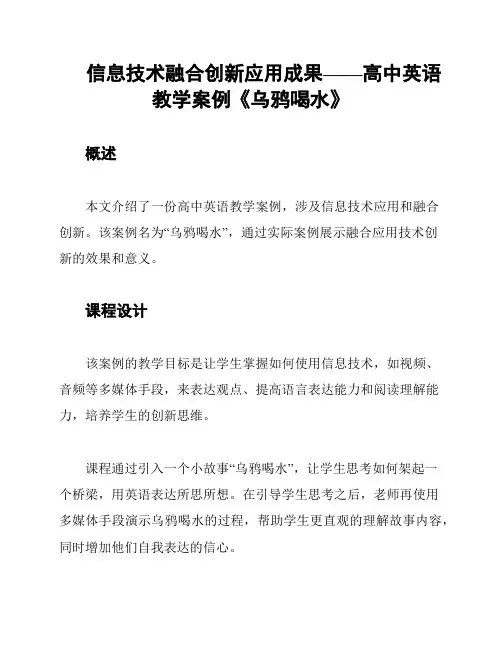
信息技术融合创新应用成果——高中英语
教学案例《乌鸦喝水》
概述
本文介绍了一份高中英语教学案例,涉及信息技术应用和融合
创新。
该案例名为“乌鸦喝水”,通过实际案例展示融合应用技术创
新的效果和意义。
课程设计
该案例的教学目标是让学生掌握如何使用信息技术,如视频、
音频等多媒体手段,来表达观点、提高语言表达能力和阅读理解能力,培养学生的创新思维。
课程通过引入一个小故事“乌鸦喝水”,让学生思考如何架起一
个桥梁,用英语表达所思所想。
在引导学生思考之后,老师再使用
多媒体手段演示乌鸦喝水的过程,帮助学生更直观的理解故事内容,同时增加他们自我表达的信心。
教学成效
通过这样的方式教学,学生的听说读写能力都得到较好的提高,同时开拓了学生的视野,让他们知晓如何运用信息技术来进行语言
表达。
结论
信息技术的应用已经深入到我们的生活之中,教育领域也不例外。
通过本案例,我们可以看到融合应用信息技术所带来的优势,
已经成为教学的趋势和未来发展方向。
高中英语教师教学案例分析范文6篇

高中英语教师教学案例分析范文6篇Teaching English at the high school level requires a deep understanding of the subject matter, effective instructional strategies, and the ability to engage and motivate students. Effective English teachers must possess a range of skills and knowledge to ensure their students develop proficiency in reading, writing, speaking, and listening. This essay presents six case studies that illustrate the diverse teaching practices and approaches employed by successful high school English teachers.Case Study 1: Incorporating Technology to Enhance Engagement Mrs. Emily Johnson, a veteran English teacher at Westside High School, has embraced the use of technology to create dynamic and engaging lessons. She regularly incorporates multimedia elements, such as interactive presentations, educational videos, and online discussions, to supplement her traditional instruction. By leveraging technology, Mrs. Johnson is able to cater to the diverse learning styles of her students and maintain their attention throughout the lesson. Her students have reported feeling more engaged and motivated to participate in class activities, leading to improvedcomprehension and academic performance.Case Study 2: Differentiated Instruction for Diverse LearnersMr. Liam Patel, an English teacher at Eastwood High School, recognizes the importance of addressing the unique needs and abilities of each student in his classroom. He employs a range of differentiated instructional strategies to ensure that all of his students, regardless of their academic level or learning preferences, have the opportunity to succeed. This includes offering tiered assignments, providing scaffolding for struggling learners, and incorporating project-based learning to allow students to demonstrate their understanding in various ways. By tailoring his instruction to the individual needs of his students, Mr. Patel has seen a significant improvement in their overall academic achievement and engagement.Case Study 3: Fostering Critical Thinking through Socratic Seminars Ms. Olivia Hernandez, an English teacher at Northside High School, is a strong proponent of the Socratic seminar approach. She regularly facilitates discussions in which students engage in deep, thoughtful dialogue about complex literary texts, challenging them to analyze, interpret, and defend their ideas. By encouraging students to question, explore, and critically examine the material, Ms. Hernandez helps them develop essential critical thinking and communication skills. Her students have reported feeling more confident in theirability to express their ideas and engage in meaningful intellectual discourse.Case Study 4: Integrating Interdisciplinary ConnectionsMr. Ethan Nguyen, an English teacher at Southside High School, recognizes the importance of helping his students make connections between the English curriculum and other academic disciplines. He regularly collaborates with teachers from other departments to design interdisciplinary units and projects that allow students to apply their English skills in a broader context. For example, he has worked with the history department to create a unit on the literature and social movements of the Civil Rights era, and with the science department to explore the intersection of literature and environmental science. By fostering these interdisciplinary connections, Mr. Nguyen helps his students develop a more holistic understanding of the subject matter and its real-world applications.Case Study 5: Emphasis on Writing DevelopmentMs. Sophia Ramirez, an English teacher at Westwood High School, places a strong emphasis on the development of her students' writing skills. She has implemented a comprehensive writing program that includes frequent opportunities for students to engage in various types of writing, from personal narratives to research-based essays. Ms. Ramirez provides detailed feedback and individualized instruction to help her students improve their writingmechanics, organization, and overall effectiveness. Her students have reported feeling more confident in their writing abilities and better prepared for the rigors of college-level work.Case Study 6: Cultivating a Love for LiteratureMr. Aiden Chen, an English teacher at Eastside High School, is passionate about fostering a love for literature in his students. He curates a diverse range of literary texts, from classic novels to contemporary poetry, and creates engaging lessons that encourage students to explore the themes, characters, and literary devices within these works. Mr. Chen also incorporates opportunities for students to engage in creative writing and book discussions, allowing them to express their personal interpretations and connections to the material. By cultivating a genuine appreciation for literature, Mr. Chen has seen his students develop a deeper understanding and enjoyment of the English language and its power to convey human experiences.These six case studies highlight the diverse teaching practices and approaches employed by successful high school English teachers. From incorporating technology to fostering critical thinking, these educators have demonstrated their commitment to providing their students with a well-rounded and enriching educational experience. By drawing upon these examples, other English teachers can gain valuable insights and inspiration to enhance their own instructionalpractices and better support the academic and personal growth of their students.。
信息技术融合创新应用成果——高中英语教学案例《乌鸦喝水》
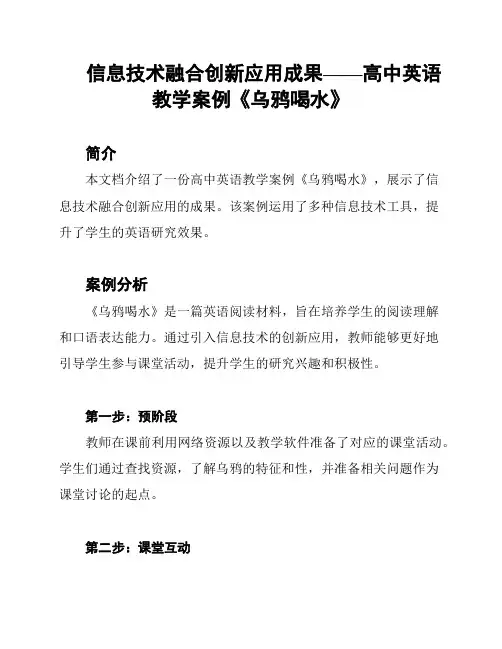
信息技术融合创新应用成果——高中英语教学案例《乌鸦喝水》简介本文档介绍了一份高中英语教学案例《乌鸦喝水》,展示了信息技术融合创新应用的成果。
该案例运用了多种信息技术工具,提升了学生的英语研究效果。
案例分析《乌鸦喝水》是一篇英语阅读材料,旨在培养学生的阅读理解和口语表达能力。
通过引入信息技术的创新应用,教师能够更好地引导学生参与课堂活动,提升学生的研究兴趣和积极性。
第一步:预阶段教师在课前利用网络资源以及教学软件准备了对应的课堂活动。
学生们通过查找资源,了解乌鸦的特征和性,并准备相关问题作为课堂讨论的起点。
第二步:课堂互动教师首先通过使用互动白板软件将阅读材料展示给学生。
学生们在听读材料的同时,教师利用投影仪展示与乌鸦相关的图片和视频,激发学生对乌鸦的兴趣。
学生们可以用语言或者软件工具标注材料中的重点内容。
第三步:小组合作学生分成小组,利用笔记本电脑或平板电脑进行小组合作。
他们可以使用电子白板软件共同编辑并呈现他们对乌鸦喝水故事的理解和表达。
学生们可以互相讨论、修改和完善自己的作品。
第四步:展示和分享每个小组派代表呈现他们的作品给全班同学。
学生们可以通过投影仪将自己编辑的内容展示给全班,以及分享他们在小组合作中的收获和思考。
效果评估通过引入信息技术融合创新应用,学生们的研究效果得到了显著提升。
他们在阅读理解和口语表达方面取得了进步,且能够灵活运用信息技术工具进行合作与展示。
教师在课堂上的角色也得到了转变,从传统的知识传授者转变为学生研究的指导者和引导者。
结论《乌鸦喝水》这个案例充分展示了信息技术融合创新应用在高中英语教学中的成果。
通过充分利用多种信息技术工具,教师能够提升教学效果,激发学生的学习兴趣和积极性,培养学生的综合能力。
这个案例可以为其他教师在英语教学中运用信息技术提供借鉴和启示。
高中英语教学设计优秀7篇
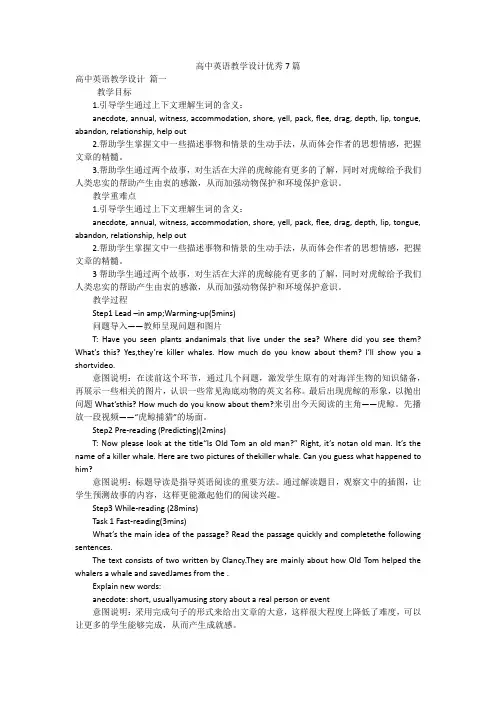
高中英语教学设计优秀7篇高中英语教学设计篇一教学目标1.引导学生通过上下文理解生词的含义:anecdote, annual, witness, accommodation, shore, yell, pack, flee, drag, depth, lip, tongue, abandon, relationship, help out2.帮助学生掌握文中一些描述事物和情景的生动手法,从而体会作者的思想情感,把握文章的精髓。
3.帮助学生通过两个故事,对生活在大洋的虎鲸能有更多的了解,同时对虎鲸给予我们人类忠实的帮助产生由衷的感激,从而加强动物保护和环境保护意识。
教学重难点1.引导学生通过上下文理解生词的含义:anecdote, annual, witness, accommodation, shore, yell, pack, flee, drag, depth, lip, tongue, abandon, relationship, help out2.帮助学生掌握文中一些描述事物和情景的生动手法,从而体会作者的思想情感,把握文章的精髓。
3帮助学生通过两个故事,对生活在大洋的虎鲸能有更多的了解,同时对虎鲸给予我们人类忠实的帮助产生由衷的感激,从而加强动物保护和环境保护意识。
教学过程Step1 Lead –in amp;Warming-up(5mins)问题导入——教师呈现问题和图片T: Have you seen plants andanimals that live under the sea? Where did you see them? What’s this? Yes,they’re killer whales. How much do you know about them? I’ll show you a shortvideo.意图说明:在读前这个环节,通过几个问题,激发学生原有的对海洋生物的知识储备,再展示一些相关的图片,认识一些常见海底动物的英文名称。
高中英语教学设计案例5篇
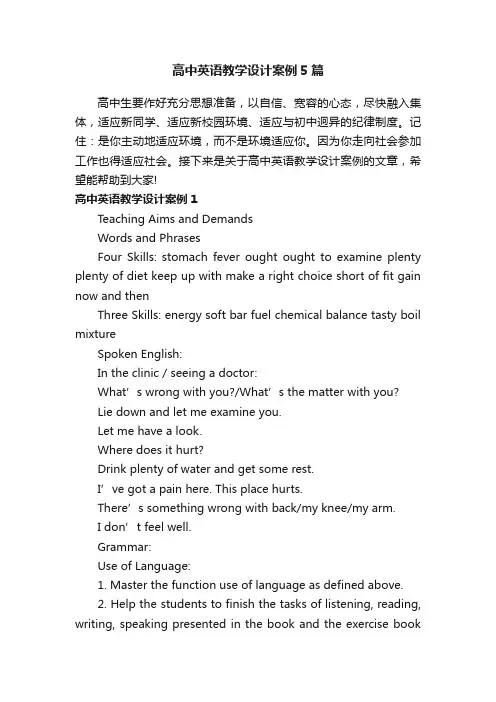
高中英语教学设计案例5篇高中生要作好充分思想准备,以自信、宽容的心态,尽快融入集体,适应新同学、适应新校园环境、适应与初中迥异的纪律制度。
记住:是你主动地适应环境,而不是环境适应你。
因为你走向社会参加工作也得适应社会。
接下来是关于高中英语教学设计案例的文章,希望能帮助到大家!高中英语教学设计案例1Teaching Aims and DemandsWords and PhrasesFour Skills: stomach fever ought ought to examine plenty plenty of diet keep up with make a right choice short of fit gain now and thenThree Skills: energy soft bar fuel chemical balance tasty boil mixtureSpoken English:In the clinic / seeing a doctor:What’s wrong with you?/What’s the matter with you?Lie down and let me examine you.Let me have a look.Where does it hurt?Drink plenty of water and get some rest.I’ve got a pain here. This place hurts.There’s something wrong with back/my kn ee/my arm.I don’t feel well.Grammar:Use of Language:1. Master the function use of language as defined above.2. Help the students to finish the tasks of listening, reading, writing, speaking presented in the book and the exercise bookthrough using what the students have learned.Learn the text about healthy eating. Get the students know about the basic knowledge of how to eat healthily.Important points:1. Talk about different kinds of food that one favorites.2. learn the basic knowledge of healthy eating.3. learn how to say in the clinic.4. Grasp the language points and grammar in the text.Difficult points: The use of modal verbs --- had better, should and ought to.Teaching aids: computer or slider-projectorWay of Teaching: Communication way of teaching, discussion and group work.Lesson 1Step 1 Warming-UpFirst show the students some pictures of dishes and so to introduce the topic of this unit.And then show the pictures on their text books and let them to decide what is junk food and what is not.Here the students may have a short ask and answer in pairs to themselves more engaged in the topic.Step 2 ListeningLet the students listen to the tape and be prepared to answer the questions below.Step 3 SpeakingShow the students the three situations as on P2. Then ask the students to prepared a dialogue according to the examples in pairs. Ask several pairs of students to present their dialogue After that list the useful expressions in their dialogue.Step 4 HomeworkPrepare for the next class.Collect some menus if possible for the next class.Lesson 2Step 1 IntroductionUsing the questions on P3 to introduce the new text.Step 2 Fast-reading1.What does the “fuel ” mean in the first paragraph?(It means different kinds of materials, such as protein, Calcium that we need to keep healthy.)2.What do we have to consider when we choose to buy or eat?(What kinds of nutrients that the food contain.)3.What made our eating habit changing?(Many things: what people believe, advice from companies and stores.)4. How can we feel and look fine?(We ought to learn about our body and the fuel it needs to keep fit.)Explain the language points if necessary.Step 3 Carefully-readingHow many parts can be divided into?(Three parts.)What’s the main idea of each part?(1.our eating habits are changing. 2.why the eating habits are changing 3.the best way to develop healthy eating habits.) Step 4 TalkingAsk the students to take out their menus and read them carefully. Then prepare a dialogue that may happen between a customer and a waiter/waitress.Step 5 HomeworkFinish the exercise --- Vocabulary on P5. and P72-73Lesson 3Step 1 RevisionCheck the homework.Step 2 GrammarFirst present the students the modal sentences with Modal Verbs and ask the students to make some sentences with them.Step 3 Consolidation(1) Finish the exercise on P5 and on P74(2)Take out a piece of paper with the column “Ask ###” in order to make the students understand when you are giving advice it is better to use some sentences with had better (not), and ought(not) to, should(not). Then read a passage as an example and afterwards list the points you have to pay attention to when you give advice.1.give advice that will really help the person.2. be polite and sincereat last get the students to finish the following practice.Step 4 HomeworkFinish the exercise 3 on P74 in the students’ workbook.Lesson 4Step 1 RevisionLet some students read their reply to the letters on P74.Step 2 ReadingRead the text on P6 and then get the students to find the main idea of it (Snacks is also important . we need to learn something about snacks and the way to prepare it.)Step 3 WritingAsk the students to work in pairs to write the recipe for their favourite dish.We may first give the tips on P7 as a guide.Step 4 DiscussionFirst ask the students to read the passage on P75 and then give the following questions as the topic for the students to talk: What is a couch potato?What does one have to pay special attention to in order to keep healthy? (food and exercise etc.)Step 5 HomeworkDo a general survey in order to learn about the differences between people’s eating habits and try to find which is healthier.高中英语教学设计案例2Teaching aims and demands:a. Achieve language skills and related knowledge about the topic of friends and friendship;b. Learn to express likes and dislikes and make apologies:c. Vocabulary in this unit:the words and expressions listed on the teacher’s bookd. Grammar:Direct and indirect speechLesson 1Step 1 Presentation and discussion (warm-up)Put some new words on the blackboard and tell them something about a friend.Kind honest brave loyal happy wise strongbeautiful handsome rich smart funnyThen ask some questions around the class and discuss with them.What should a good friend be like?What qualities should a good friend have?Should they be funny, smart and strong?Step 2 ReadingAsk the students to read the dialogue in the part SPEAKING. Ask some questions:1.What doesn’t John like?2.What does Joe think of music and skiing?And then fill in the form on page 3.Then ask the students to express their ideas freely. Encourage the students to say more about friends.Step 3ListeningAsk the students to listen to the tape and fill in the blanks in the listening part.Step 4 Talking/PracticeAsk the students to page 85. Make a similar dialogue as in exercise 2.Some useful expressions :Why did you…? Why didn’t you…? You said that you would…Please forgive me. You promised to … I’m very sorry… It won’t happen again. I forgot.Step 5 HomeworkFinish Exercise 3 in the workbook.Lesson2Step1 RevisionAsk several students to present a speech about friends as a revision.Step 2 Pre-readingPresent the students a picture to illustrate the situation on a lonely island. Ask them to list three items in the box and ask them to give the reasons using the sentences listed on page3.Step 3 ReadingBefore asking the students to read the text, first give the students a brief introduction about Tom Hanks, his films and the film Cast Away.Then students read the text, and answer the following questions.1.How does Chuck Noland come to a deserted island?2. In order to survive on the island alone, what does he need to learn?3. What does he understand at last?4. For us, what lesson we can learn from Chuck?At the same time explain the language points if necessary.Step 4 Post-readingDiscuss the following questions in the Part POST-READING.Step 5 HomeworkPrepare a talk about Tom Hanks or something about one of his film.Lesson3Step 1 RevisionGet the students to give a talk about Tom Hanks or something about one of his films.Step 2 Language StudyAsk the students fill in the blanks with proper words.Step 3 GrammarIllustrate to the students the use of Direct and Indirect Speech.Then ask the students to do the exercise in the Part Grammar on P5.Step 4 PracticeAsk the students to act the exercise2 in the part Grammar out.Step 5 HomeworkAsk the students to finish the exercise2 in their workbook.Lesson4Step 1 RevisionCheck the homework.Step 2 PresentationPresent simples of e-mail to get the students a general idea of e-mail.Step 3 ExplanationTell the students some tips of writing an e-mail by learn the above e-mail simple.Step 4 WritingAsk the students to write an e-mail message.Step 5 HomeworkAsk the students to try to write an e-mail to their e-pal.高中英语教学设计案例3Ⅰ. Teaching Basis (教学依据) :《普通高中英语新课程标准》Ⅱ. The Type of the Text (课型) :Revision (复习课)Ⅲ. Teaching Methods(教学方法): Question-based method(提问式),Group discussionmethod(小组讨论法),Cooperative learning(合作探究),Practicing(练习).Ⅳ. Teaching Aids (教学手段) :Multimedia computer(多媒体电脑),Learningpaper(导学案),Blackboard(黑板).Ⅴ. Teaching Aims(教学目标) :①Knowledge aims(知识目标): words: achievement, specialist, organization, hard-working, confident….. phrases: put to death, mean doing, either…or…, the bond between……, structure: only+…., It is/was+….+that…. grammar: Subject-verb agreement.②Ability aims(能力目标): Develop the students’ ability to use the importantlanguage points, enable students to describe people using the adjectives.③Emotional aims(情感目标): Encourage the students to think about what makes aperson great.Ⅵ. Teaching focuses(教学重点):Get the students to review and consolidate what theyhave learned in this unit.Ⅶ. Teaching difficulties(教学难点):Get the students to turn what they have learned intotheir ability.Ⅷ.Teaching procedure(教学过程): Step 1 复习学案情况反馈(1分钟)Step 2 lead-in :通过图片展示的方式,过渡到知识竞答类节目《一站到底》,本节课也将模仿这种模式授课。
核心素养下的高中英语教学设计案例——牛津高中英语M6Unit1ProjectTheimportant
核心素养下的高中英语教学设计案例——牛津高中英语M 6 Unit 1 Project The important papers 教学设计发布时间:2022-11-12T16:54:05.388Z 来源:《中小学教育》2021年5月1期作者:李红妹[导读]李红妹湖南省郴州市湘南中学中图分类号:G688.2 文献标识码:A 文章编号:ISSN1001-2982 (2021)05-058-01一、教材分析本课选自牛津译林模块六第一单元Project。
Project中安排了两个简短的戏剧,通过两部简短的戏剧来突出呈现本单元中心话题。
本课是其中一个戏剧,让学生了解什么是戏剧,给学生一个表演戏剧和展示自己的机会。
通过戏剧表演,学生可了解进行戏剧表演需要做哪些准备,在期间学会团队合作,然后完成自己的任务。
二、学情分析:高二的学生具备一定的英语基础。
但高二学年的英语教学将继续培养和优化学生的英语学习方法,使他们能通过观察、体验、探究等主动学习的方法,充分发挥自己的学习潜能,提高自主学习的能力。
同时,注重和加强学生情感教育和心理教育。
三、教学目标:1.Understand what the play is about. (理解戏剧大意)2.Learn how to cooperate as a team and how to fulfill each part of the work. (学习团队合作和完成合作的每一部分任务)四、教学重难点:1. Learn to cooperate as a team and fulfill each part of the work. (学习团队合作和完成合作的每一部分任务)2.Students are expected to put on the play in class. (展示戏剧)五、教学方法:进行探究性学习,任务型教学法六、教学手段:多媒体辅助教学七、教学过程:Step 1 Lead-in Enjoy a videoTeacher uses the question “Have you ever acted in a play?”to introduce the topic , and the ask the students to enjoy a video about a play The Merchant of Venice .设计意图:威尼斯商人戏剧视频导入,引入话题,更直观更形象。
高中英语优秀教学案例六篇
高中英语优秀教学案例六篇英语教学案例1一、教学目标1.能够听懂、会说几个重要节日的词汇,并能用英语表达这些节日所在的月份。
2.能够以图文并茂的形式介绍自己喜欢的某个节日。
3.欣赏并学唱关于月份的歌曲。
二、教学建议A. Good to know.1.热身与复习(1)复习12个月份的英文表达①教师引导学生认读月份名称的单词卡片,随即发给读词最快的学生。
②拿到词卡的学生一起站到教室前面,按月份的顺序排队。
③全班再次按顺序说出12个月份的英文表达。
(2)教师呈现年历或第一课时歌谣课件,引导学生演唱第一课时所学的歌谣。
(3)师生交流:When is your birthday? It‘s in ...2.学习新知(1)教师呈现母亲节图片,引导学生观察画面内容,如:Who are they? What is the girl doing? Why is she giving flowers to her mother? Is it her mother’s birthday?...引出Mother‘s Day之后,让学生跟读词汇。
英语教学案例2一、语言技能目标第一层次:1.能够听懂、会说衣服词汇cap,coat,shoes,sweater,jacket,gloves,trousers;能在四线三格中基本规范地抄写单词,并尝试借助拼读规律记忆单词。
2.能够听懂、会说用来介绍复数衣服的功能句:These are ...3.能够听懂、会说用来询问自己该穿什么衣服的功能句:What should I wear today?及其答语:You should wear ...,初步学会在恰当的情境中运用,并通过描摹句子来体会句子书写规范,为抄写句子和独立写句子打基础。
4.能够读懂介绍自己所在城市的季节、天气、穿衣情况以及询问对方城市相关情况的小书信;并通过替换小书信中的关键信息回信,介绍自己的上述情况,回复朋友的询问。
5.能够借助熟悉的旧单词和图片感知字母u在闭音节单词中的发音规律,并利用该规律拼出新单词的读音,进而尝试记住其写法。
高中英语教学案例及其分析
高中英语教学案例及其分析案例一: 提高学生听力能力案例描述在某高中英语教学中,学生的听力成绩相对较低,教师决定采取以下策略来提高学生的听力能力:1. 引入真实语境:通过给学生播放真实的英语对话录音材料,让学生从中感受到语言环境的真实性和多样性。
2. 课堂互动:教师在课堂上组织学生进行听力活动,包括听力对话、听力填空、听力选择等,以增加学生的听力训练机会。
3. 听力技巧训练:教师向学生介绍一些有效的听力技巧和策略,如细听、预测答案、注意关键词等,帮助学生提高听力能力和应对考试。
案例分析通过采取以上策略,学生的英语听力能力得到了明显提高。
学生们更加主动参与听力活动,积极运用学到的听力技巧,提高了听力表现和考试分数。
在这个案例中,教师注重真实语境和互动的教学方法,使学生能够在语言环境中感受到英语的真实性,从而提高听力能力。
此外,教师的技巧训练也帮助学生掌握了一些解题技巧,提高了应试能力。
案例二: 提升学生口语表达能力案例描述某高中英语教学中,学生的口语表达能力较差,教师决定采取以下策略来提升学生的口语能力:1. 组织口语练:教师组织学生进行口语练,包括角色扮演、小组讨论等活动,以提高学生的口语表达能力和流利度。
2. 激发学生兴趣:教师引导学生选择与自己兴趣相关的口语话题,并鼓励学生进行自由表达和互动交流,增强学生对口语的研究动力。
3. 提供反馈和指导:教师及时给予学生口语表达的反馈和指导,帮助学生发现问题并改进口语表达,同时鼓励学生积极尝试和进步。
案例分析通过以上策略的实施,学生的口语表达能力得到了明显提升。
学生们在口语练中更加自信和流利,能够积极参与讨论和交流,表达自己的观点和想法。
在这个案例中,教师重视口语练和兴趣驱动的教学方法,通过提供反馈和指导,帮助学生改进口语表达。
此外,教师的激发学生兴趣也起到了积极的作用,增强了学生对口语研究的主动性和积极性。
结论通过以上两个案例的分析,我们可以得出以下结论:1. 在教学中引入真实语境,可以帮助学生感受到语言环境的真实性,提高听力能力。
高中英语教学案例范文三篇
高中英语教学案例范文三篇1.介绍俄罗斯遗失琥珀屋的轶事2.研究描述世界文化遗产的起源、发展和保护等方面的情况3.提高阅读技能,让学生自己归纳课文内容4.结合中外文化遗产一起讨论,引起共鸣5.研究如何谈论文化遗产,形成保护文物的意识。
四、教学过程1.引入:通过图片展示和视频介绍,让学生了解世界文化遗产的概念和意义,引起学生对文化遗产的兴趣。
2.阅读课文:让学生自己阅读课文,并在阅读过程中记录重要信息,例如人名、地名、时间、事件等。
3.归纳课文内容:让学生自己归纳课文内容,并进行讨论,帮助学生理解课文。
4.结合中外文化遗产讨论:让学生结合自己所了解的文化遗产,进行讨论,引起共鸣。
5.研究如何谈论文化遗产:让学生研究如何谈论文化遗产,例如如何描述文化遗产的起源、发展和保护等方面的情况。
6.总结:让学生总结本节课所学内容,并形成保护文物的意识。
五、教学反思本节课的教学效果还不错,学生对文化遗产的意义和重要性有了更深入的了解,也学会了如何谈论文化遗产。
但是,在教学过程中,我发现有些学生对课文内容的理解还不够深入,需要加强课后的巩固。
同时,我也需要更好地掌握学生的研究水平,让教学内容更加贴近学生的实际情况。
教学过程:一、引入教师通过图片和录音引入文化遗产的话题,展示琥珀屋的新旧图片,给学生感官上的刺激,帮助学生理解文章。
教师可以在板书上记录一些生词。
二、精读练学生阅读课文后进行精读练,回答问题掌握细节,了解琥珀屋从形式-失踪-重建的过程,从整体上把握它的结构、特色,并研究用英语归纳以及复述。
三、设计小对话两人围绕琥珀屋设计小对话,练口语表达能力,同时研究难句的解释。
四、小结文章学生找关键线索,分析文章的写作手法,小结上完这节课的收获,使他们的掌握阅读技巧的同时也增加了见识。
五、小组讨论学生进行小组讨论,复述课文,加深对文章的理解,并总结自己通过本课研究学到了什么,达到教学目标--形成保护文物意识。
六、教学策略教师采用多媒体教学,用一些有关文物的精美图片,引起学生对即将阅读的文章的兴趣,减少陌生感。
- 1、下载文档前请自行甄别文档内容的完整性,平台不提供额外的编辑、内容补充、找答案等附加服务。
- 2、"仅部分预览"的文档,不可在线预览部分如存在完整性等问题,可反馈申请退款(可完整预览的文档不适用该条件!)。
- 3、如文档侵犯您的权益,请联系客服反馈,我们会尽快为您处理(人工客服工作时间:9:00-18:30)。
一个高中英语教学案例
随着新一轮的高中课程改革的展开,信息技术给我国的教育事业带来了巨大的挑战。
信息技术在教学中的应用引起了教学内容、教学方法、教学组织形式等系列变化,导致了教学思想,教学观点,以及教学体制在一定水准上的变化。
本案例就是借助于信息技术制造CAI课件实行辅助教学。
一、教学背景
教学对象是高一学生,英语基础知识和基本技能都是一般水平,对英语学
习兴趣不浓,所以,调动学生的学习兴趣,以学生主动学习为目标。
二、教材分析
本课例是高一必修1第一模块里的unit3,welcome to the unit,转绕“looking good,feeling good”这个健康主题,主要通过网络,电影的形式展开学习活动,让学生观看电影并自主通过网络查找资源,协作学习,通过讨论,了解当今人类的健康问题。
要求学生学完本课后能够熟练使用英语表达自己的看法,并且准确理解健康的重要性。
最突出特点是让学生尝试“自主学习,主动思考,乐于协作,勇于创新”。
利用网络资源使学生的学习活动变得多元化。
人机互动——师生互动——生生互动。
三、教学目标
1.让学生注意他们的健康,不要为了自身的身材吸引人而忽略了健康问题。
2.让学生通过讨论图片来提升英语口语水平。
四、教学重点、难点
1.教学重点
训练学生听说水平
2.教学难点
提升学生口语水平
五、教法
探究式和师生互动
六、教学辅助手段
计算机、自制CAI课件和学生学习支持材料。
七、教学课程设计与分析
Step 1. Presentation
Teachers use the pictures connected with heath to lead in . show some pictures of some famous people and think of these questions:
Is a person’s ability judged by their appearance?
Which do you think is more important, looking good or feeling good?
教师:让学生发表自己的见解,以这种方法导入课题,引起学生对问题的探究,也培养了学生观察问题的水平。
Step 2 Discuss
Choose four pictures and have a free talk
Show four pictures to let them know the importance of health and let them talk freely.
eg .who is the person?
The reason why he does so as the picture shows。
Gave some detail about the picture
教师:通过看图谈论,直观地将本课内容以图片体现出来,充分培养了学生使用语言交际的水平和自主学习水平,充分调动了他们的积极性和创造性。
Step 3. Talk about the pictures and search for the information and discussion。
Let students watch some pictures about the problems which our human beings are facing, and then surf the internet to find out some information about the phenomenon and the cause of the problems。
At the same time they can have a group discussion, Finally each group presents their own opinions。
教师:让学生再次观看一些图片,并上网查找有关这些问题的现象和原因,同时进行分组自由讨论,最后学生展示本组查找结果。
这样,既让这生大胆地开口说英语,进行了口语表达,又让学生形成自主学习的能力,调动了他们学习英语的兴趣。
体现了“以学生为本”的教学理念。
Step 4。
Watching and acting
Watch some move clips,and then discuss the fat problems will affect human beings in the future,and then ask two groups to act out how to solve the fat problems,Then two students summarize their own opinions。
教师:让学生观看一些《瘦身男女》的电影片段,并讨论肥胖问题对未来人类造成的影响。
以此来使课堂气氛活跃,让学生踊跃参加活动,充分调动学生的学习积极性,自主性,协作性。
Step5 .conclusion (总结)
Make a conclusion about how we can do to keep healthy and draw a conclusion according to the students’answers.
老师:总结我们怎样保持健康,并根据学生的回答作一个总结。
Step6. Homework
1.Choose one picture on P41, and write down the details about it.
2.Preview the reading text.
案例分析:
1.利用多媒体制作课件,增大了课堂容量,加大了练习的力度。
也加快了课堂的节奏,该课例成功地运用了多媒体手段和有效网络资源开展学生的学习活动,生动形象地展示了“健康的重要性”,课堂气氛活跃,学生踊跃参加活动并取得了良好的效果。
2.利用网络,电影及图片资源,充分调动学生的学习积极性、自主性和协作性。
让学生自主上网查找资源,激烈讨论,踊跃发表自己的意见并且尝试演绎小品。
充分体现了“以学生为本”的教学理念。
3.在整个过程式中始终贯穿着培养学生的各方面能力。
全方位开发学生的潜能。
这种教学设计克服了传统的教师讲,学生记的弊病,学生在教师引导下学会了思考,学会分析,学会发现,学会表达,真正发挥了学生的主体作用,和教师的主导作用,课堂上能做到全面提高学生的英语能力,通过师生,生生交流合作、探究,取得很好的教学效果。
4.学生普遍对这种网络课的形式表示欢迎,提高了他们学习英语的兴趣,完全感觉到不同于普通的教学课堂教学,我认为网络资源为学生提供了充分的,均等的机会,达到了非常好的效果,体现了“素质教育”的精神。
